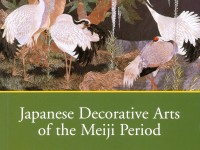Japanese Decorative Arts of the Meiji Period
A catalogue of the Ashmolean’s Japanese decorative arts from the Meiji period (1868-1912), by Oliver Impey and Joyce Seaman (published Oxford, 2005).

Publications online: 54 objects
- Reference URL
Actions
Incense burner, or kōro, with an entrance gate amid trees
-
Literature notes
Baluster shaped incense burner with a lid pierced as a chrysanthemum. A building appears amid trees in a landscape in gold wire on a green ground. Signed; Kyōto Namikawa on a silver tablet.
Turning to landscape as a subject, in the early 1900s, Yasuyuki was almost obliged to use shaded backgrounds, which he had usually avoided before. In this gold-wired incense burner, there is another new technique, the use of triangular cross-sections of wire set in the picture end on, to act as leaves or flower-petals. -
Details
- Associated place
-
Asia › Japan › Honshū › Kyōto prefecture › Kyoto (place of creation)
- Date
- c. 1905
- Artist/maker
-
Namikawa Yasuyuki (1845 - 1927)
- Material and technique
- metal, inlaid with gold wire cloisonné enamel; silver mounts
- Dimensions
-
with lid 8.9 cm (height)
without lid 7.6 cm (height)
7 cm (diameter)
- Material index
-
processed material › metal › gold,
- Technique index
- Object type index
- No. of items
- 2
- Credit line
- Purchased with the assistance of the Story Fund, 2000.
- Accession no.
- EA2000.180
-
Further reading
Impey, Oliver, and Joyce Seaman, Japanese Decorative Arts of the Meiji Period 1868-1912, Ashmolean Handbooks (Oxford: Ashmolean Museum, 2005), no. 37 on p. 78, pp. 8, 22, & 74, illus. pp. 78-79
Glossary (3)
cloisonné, koro, kōro
-
cloisonné
Decorative technique in which wires are attached to a metal body and coloured enamels are applied between the wires.
-
koro
A Japanese incense burner.
-
kōro
A Japanese incense burner.
Location
Objects are sometimes moved to a different location. Our object location data is usually updated on a monthly basis. Contact the Jameel Study Centre if you are planning to visit the museum to see a particular object on display, or would like to arrange an appointment to see an object in our reserve collections.
Collection trails
Galleries
Publications online
-

Japanese Decorative Arts of the Meiji Period
Baluster shaped incense burner with a lid pierced as a chrysanthemum. A building appears amid trees in a landscape in gold wire on a green ground. Signed; Kyōto Namikawa on a silver tablet.
Turning to landscape as a subject, in the early 1900s, Yasuyuki was almost obliged to use shaded backgrounds, which he had usually avoided before. In this gold-wired incense burner, there is another new technique, the use of triangular cross-sections of wire set in the picture end on, to act as leaves or flower-petals.
Notice
Object information may not accurately reflect the actual contents of the original publication, since our online objects contain current information held in our collections database. Click on 'buy this publication' to purchase printed versions of our online publications, where available, or contact the Jameel Study Centre to arrange access to books on our collections that are now out of print.
© 2013 University of Oxford - Ashmolean Museum









